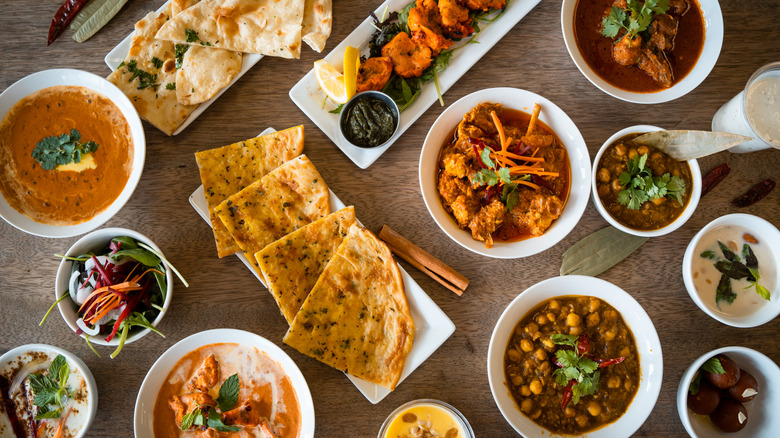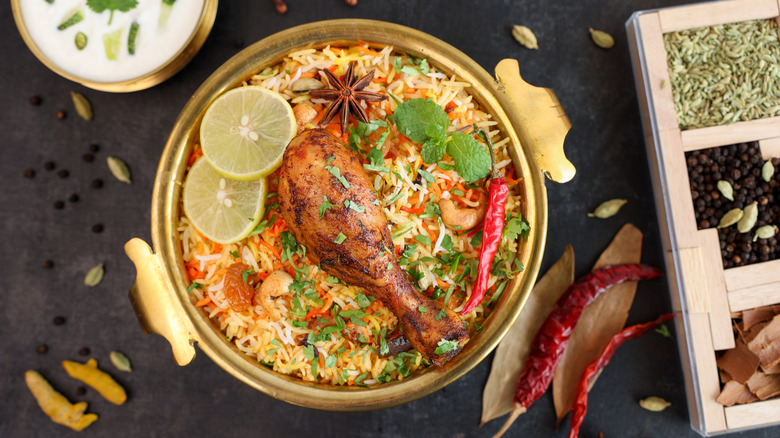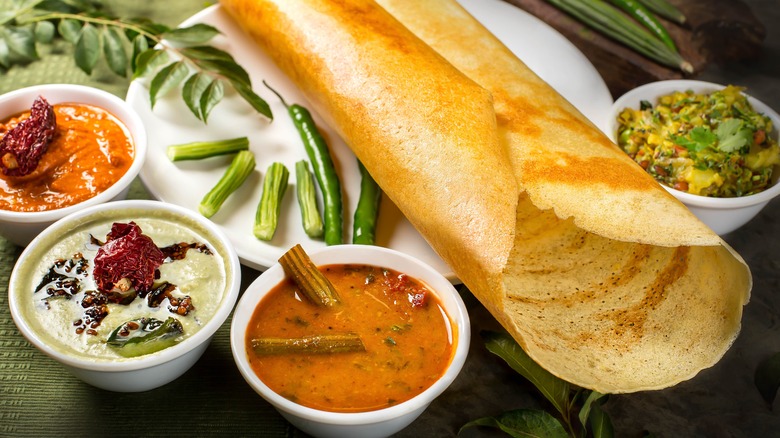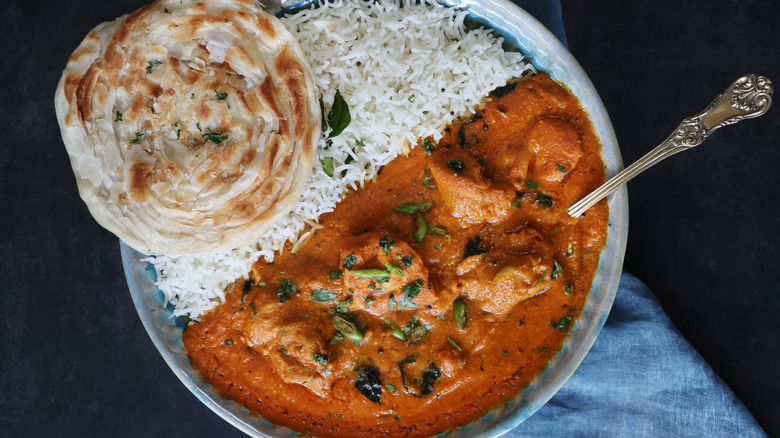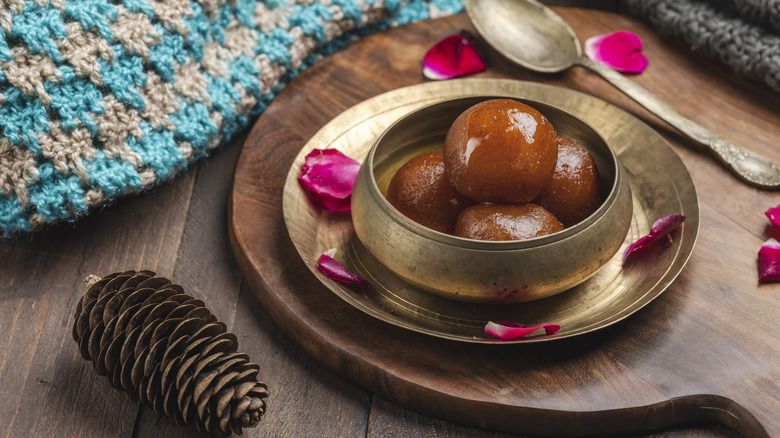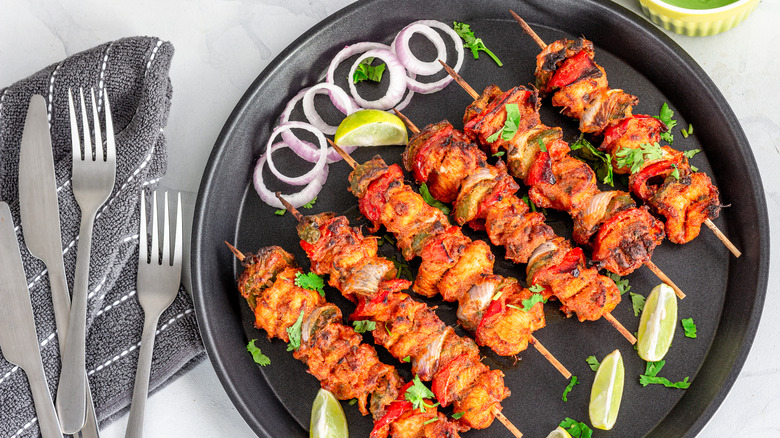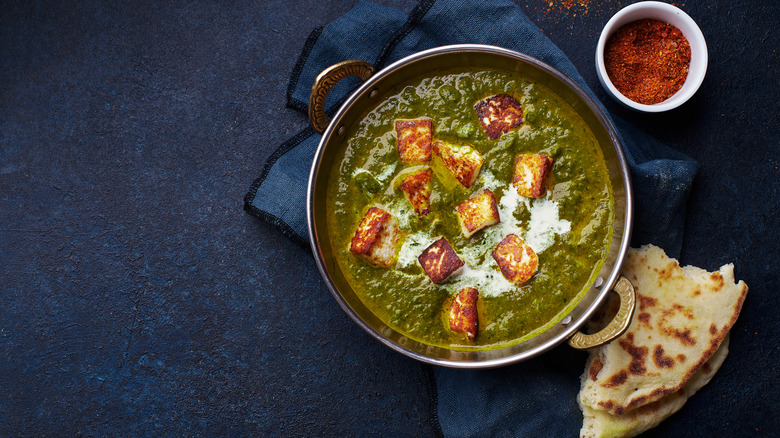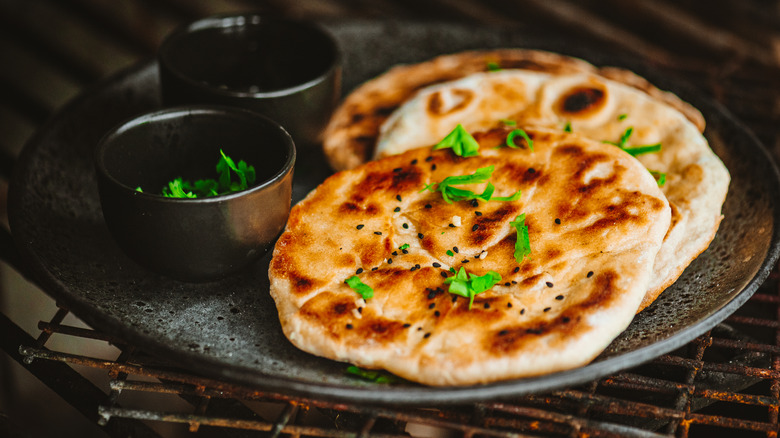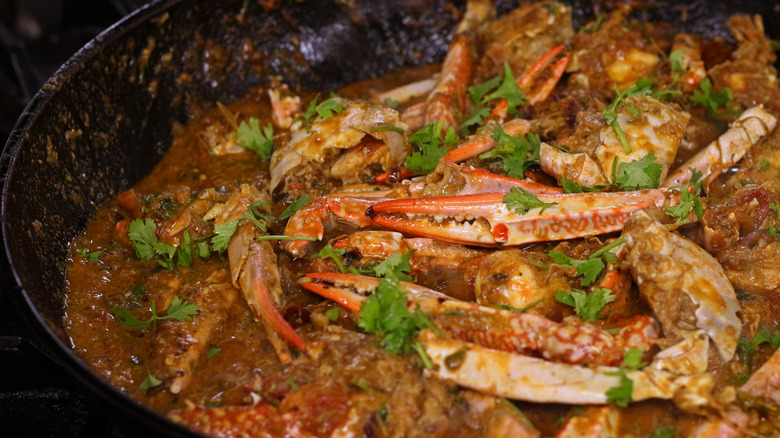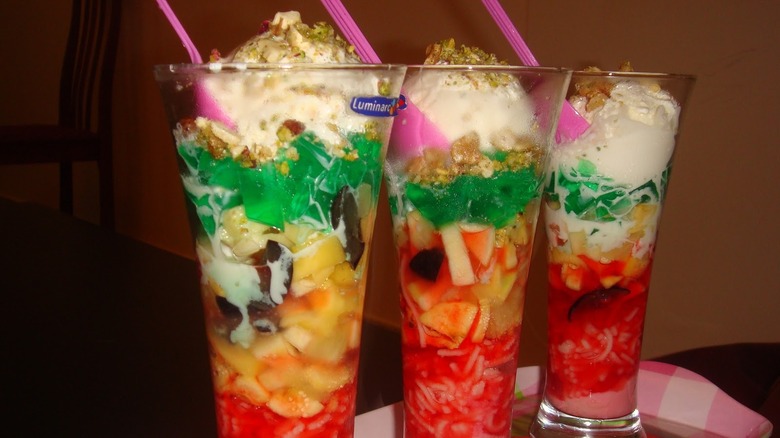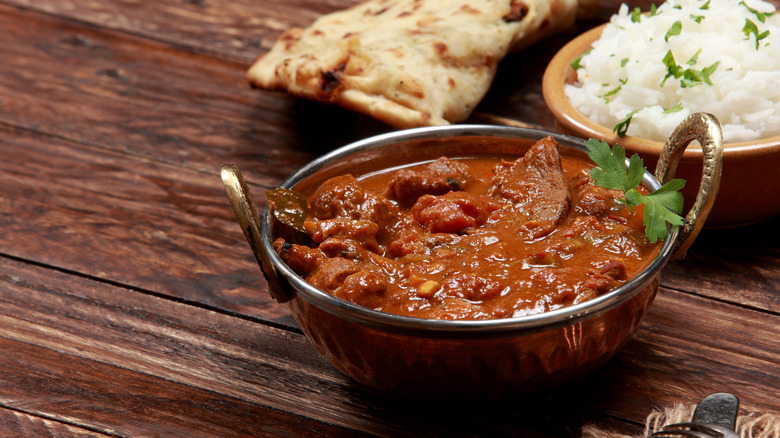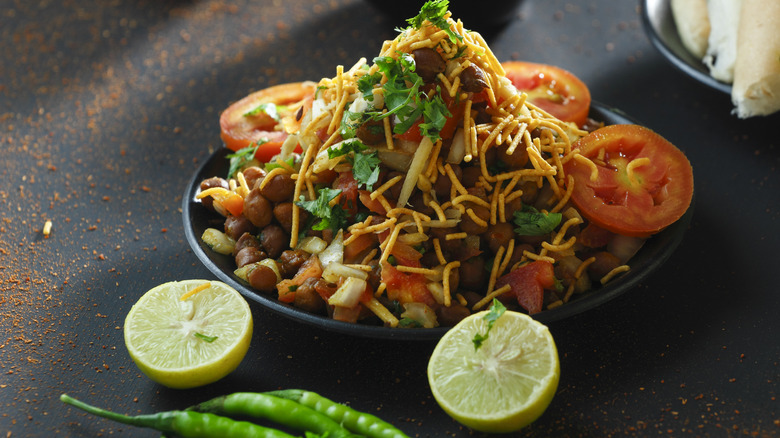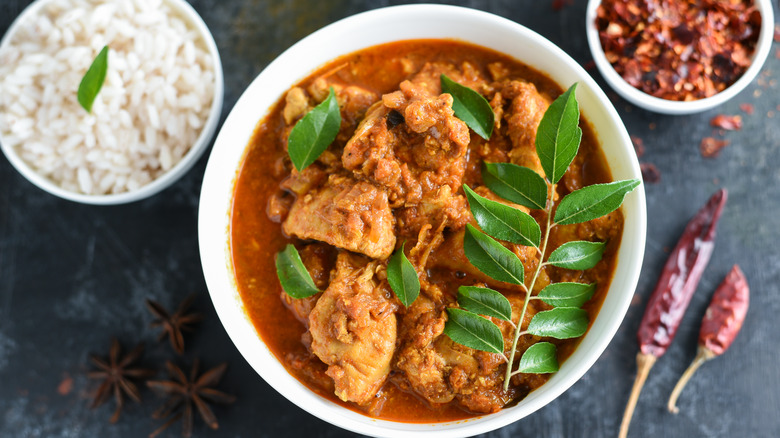12 Indian Dishes You Should Try At Least Once
Indian cuisine is one of the richest and most varied in the world, known for its fearless use of spices and its perfectly balanced flavors. From North India's creamy, comforting curries to South India's fiery palette, foodies can find a wealth of flavors and dishes to explore. Indian cuisine also has plenty of options for vegetarians — South Indian Udupi cuisine is strictly meat-free, while popular street foods like chaat are often suitable for vegans. Beyond this, the vast selection of Indian bread would put a Parisian bakery to shame.
Despite its complex spice blends, Indian cuisine often uses traditional cooking methods that are brilliant in their simplicity. Tandoor ovens lock in heat to help cook food in its smoke and juices, leading to sumptuously tender meat and perfectly roasted vegetables. Techniques like marinating and blooming whole spices in oil also help to enhance flavors and maximize taste. I love experimenting with Indian food, whether that's ordering from restaurants or cooking at home.
A big batch of healthy vegetable biryani is one of my favorite things to make — it keeps in the fridge for several days and is delicious hot or cold. A buttery murgh makhani, on the other hand, is the perfect weekend treat. With Indian food, there is just so much to discover. These 12 Indian dishes are just a taste of this incredible cuisine.
1. Biryani
Biryani is an aromatic rice dish usually made with yogurt, saffron, and caramelized onions. This dish has been an important meal in Indian cuisine for hundreds of years, with records of it being eaten during the early Mughal Empire, which ruled India from the 1500s to the 1800s. It is a popular wedding dish and is often served at large gatherings and celebrations. Biryani can be made with meat — usually lamb or chicken – or can be vegetarian.
Biryani meat is marinated overnight in a yogurt and spice mix, which helps tenderize it and speeds up cooking time. It is then either pre-cooked or placed at the bottom of the biryani pot and layered with partially cooked basmati rice, fresh herbs, and fried onions that have been fried in oil with whole spices. This spice-infused oil can be drizzled over the rice to add flavor along with butter or ghee.
Saffron is layered through the rice to give the dish its signature yellow tint. Traditionally, biryani is finished over an open fire once the pot is covered, but cooking it in the oven works just as well. This allows the rice to absorb steam and finish cooking. Biryani is often served with hard-boiled eggs and can be eaten with naan bread. Perfectly cooked biryani rice is well-separated and fluffy, while the fried onions and spiced meat give it a slightly sweet, fragrant taste.
2. Dosas
Popular as a street food across India, dosas are rice and lentil flour pancakes that are usually served along with vegetable curry. The batter is made by combining rice flour and black lentil or mung bean flour (urad dal) with water and leaving it to ferment at room temperature.
Fermentation is an important part of the dosa-making process as this is when dosas develop their light, fluffy texture. When bacterial growth occurs during fermentation, it breaks down sugars in the batter and results in air bubbles. These bubbles give the batter a light, foamy quality, and a slightly tangy flavor when cooked.
Like Western pancakes, dosas are usually cooked in a small amount of oil or ghee on a hot griddle. The curry fillings for dosas vary depending on region. Some of the most popular options are masala dosa — a potato curry dosa that is common in Mangalore – and a vegetable and lentil stew known as sambar. Sweet and sour chutneys also make a delicious dosa condiment.
3. Murgh Makhani
Murgh makhani, often referred to as butter chicken, is a rich, mild curry that's extremely popular on Indian restaurant menus. The dish originated in North India and usually brings together slow-cooked chicken and a tomato-based sauce that's thickened with butter and cream. To make murgh makhani, chefs usually start with a traditional curry base of onions fried in oil with chilies, ginger, garlic, garam masala, fenugreek, and cumin.
You can then add tomato puree, or add chopped tomatoes and blend and strain the mixture to get rid of the tough skins and seeds. This helps to achieve makhani's famously smooth and silky consistency. Butter and cream or yogurt are then added to finish the sauce.
Murgh makhani is also generally prepared using yogurt-marinated chicken that's off the bone – thighs are ideal because they stay moist while cooking compared with breast, which can easily dry out. Many Indian restaurants roast the meat in a tandoor oven before adding it to the sauce as the charcoal fire lends the chicken a mouthwateringly smoky taste. If you're making murgh makhani at home, however, you can just fry your chicken in a pan before you add your curry sauce. Just be sure not to stir it too much when it first goes in to allow the meat to brown properly.
4. Gulab Jamun
While most people are familiar with savory Indian dishes, Indian desserts are not that well-known in Western food culture. One popular Indian sweet is gulab jamun — deep-fried dough balls coated in sugar syrup. Gulab jamun is considered to be one of India's oldest desserts, possibly entering the cuisine from the Middle East during the Mughal Empire. They can be found all over India and are often served at street food stalls, festivals, and celebrations.
Gulab jamun is similar to western donuts, except that donut batter generally mixes flour and oil, while gulab jamun batter relies heavily on milk. To make gulab jamun, milk is stirred on low heat until it begins to solidify. The solids are then mixed with flour and rolled into bite-sized balls – an experienced pro will get the same size and shape across a whole batch. The dough is also often lightly fragranced with cardamom.
The gulab jamun are dropped into hot oil and deep fried, giving them a crisp outer texture and a dense, spongy middle. When you combine this with the rose syrup — the gulab jamun are steeped in it after cooking so that the flavor soaks into the dough – you get a sticky, glistening pile of irresistible treats.
5. Tandoor-grilled skewers
Indian tandoor dishes combine two of India's most famous cookery techniques — marination and tandoor grills. On many Indian restaurant menus, you'll find a tandoor section, which features marinated meat cooked on the grill, which is sometimes served kebab-style on skewers. Popular options include chicken tikka (marinated chicken skewers), roasted vegetables, or lamb skewers. The variations are almost endless and the juicy, slightly charred taste of tandoor-cooked meat is impossible to forget.
Tandoor ovens have been a staple of Indian cuisine for thousands of years. Early models were deep clay pots that were buried in the ground, while others were portable. Tandoors were usually heated with wood or charcoal fires in the base and sealed at the top, allowing the heat to concentrate in the clay walls. This technique essentially allows chefs to achieve several cooking methods at the same time — grilling, smoking, and baking.
Tandoor skewers can be placed directly into the tandoor and can cook while hanging or leaning upright. The heat from the walls and charcoal underneath roasts and crackles the marinated surface, while the juices drip onto the grill below. This creates smoke which provides the charred flavor and intensifies the spices from the marinade. The sealed chamber also helps the meat retain moisture, which could otherwise escape through steam.
6. Palak Paneer
Paneer is a common Indian cheese known for its bouncy, soft texture and its ability to hold its shape when cooked. One of the most delicious paneer recipes is palak paneer — a spinach-based curry often served with rice, naan, or roti. Palak paneer is a great option for vegetarians as the mild, chewy cheese and spinach sauce make this dish hearty, filling, and crammed with protein and vitamin K.
Similar to western cottage cheese, paneer is made by fermenting milk with an acid source — usually lemon juice. This curdles the milk and allows you to separate the liquid whey from the curds, which will then set into cheese. Unlike saag dishes, which are usually made with spinach and other leafy greens, palak paneer only uses spinach. This gives the dish its fresh green color and a slight taste of iron.
To make palak paneer, the spinach leaves are usually blanched first and then blended to create a smooth paste. This sauce is then combined with sauteed onions, tomatoes, and spices, such as chilies, cumin, cardamom, fenugreek, and cloves. The paneer is cut into cubed chunks and then simmered in the liquid to warm through. You can add some more richness to the dish by pouring in some cream.
7. Naan bread
Indian cuisine has a vast and varied tradition when it comes to bread. From layered paratha bread to fabulously puffy puri, you'll find Indian bread in all shapes and sizes served alongside curries or served solo as tasty, filled snacks. One of the most common Indian breads is the naan — a large flatbread that's usually cooked in a tandoor oven. Traditional naan cooking techniques involve sticking the dough to the tandoor walls to bake the bread or cooking it on a cast iron skillet.
Unlike many bread doughs, which are usually made from flour and water, naan dough also includes a small amount of milk. This gives the bread a soft, almost gummy consistency, which makes naans feel slightly stretchy when they're warm out of the oven. Naan is also a leavened bread — meaning that it contains yeast — which helps it to rise and gives it a thick, fluffy texture. It's perfect for mopping up sauces or scooping up curry meat and is often brushed with ghee while hot to give it a moist, golden finish.
8. Jenji Gassi
If you love spice, traditional south Indian dishes like jenji gassi are a must-try. South Indian dishes are hugely varied and are distinct from North Indian cuisine in many ways as they tend to be hotter and often contain fruit and tamarind – a sour fruit paste popular in tropical countries, like Thailand and Indonesia – to give dishes a tangy or sweet and sour flavor. Coconut is also a common substitute for yogurt or dairy in south Indian cuisine and many southern regions have a strong Udupi, or vegetarian, influence.
South India also has many coastal regions that incorporate seafood into common dishes. Jenji gassi is a crab curry that is popular in the southern city of Mangalore, which is known for its spicy fish curry or gassi. This tasty shellfish dish is made using a spice mixture of fenugreek, pepper, chilies, cumin, coriander, and turmeric. Grated coconut mixed with water provides the creamy base, while tamarind introduces its unique zesty flavor.
Jenji gassi is usually made using the whole crab and many traditional recipes boil the crab claws in the curry sauce. Cooking crab requires a light touch and the shellfish only needs to simmer for around 10-15 minutes before serving. The salty and sweet flavor of the crab meat is a perfect complement to the tangy curry sauce.
9. Falooda
Falooda is a cross between a dessert and a milkshake and looks like an extravagant ice cream sundae topped with chopped nuts and candied fruit. Falooda is popular in India and Iran, as well as parts of Asia, and is commonly enjoyed as a summer treat. At its core, Falooda is an elaborate ice cream shake, but Indian Falooda contains many ingredients that you wouldn't find in a Western drink. For instance, many versions of Falooda contain rose-flavored jelly, making this dessert somewhat similar to a British trifle or knickerbocker glory.
Falooda also contains milk, fresh fruit, vanilla ice cream, rose syrup, and vermicelli noodles made from cornstarch. These add a second, jelly-like texture to the beverage and bring an interesting visual component as the noodles turn pink in the syrup and press up against the glass. This starchy element is reminiscent of tapioca pearls that are added to Taiwanese bubble tea.
Sabja seeds or basil seeds are then added to give the Falooda a slightly chewy, fibrous texture. All the ingredients are layered in a tall glass and the top is drizzled with syrup and often garnished with a glace cherry. It's one to try if you've got kids or if you're a big fan of sweet and creamy desserts.
10. Rogan Josh
Rogan Josh is a meat curry that is common in the north Indian Kashmiri region. Spiced with Kashmir chilies to help give it a red sauce, Rogan Josh is usually made with lamb in Western restaurants and is a popular goat curry in India. Important herbs and spices in Rogan Josh include Kashmiri chili powder, asafoetida or hing, ginger, green cardamom, and saffron.
Despite its bold crimson color, Rogan Josh does not traditionally call for fresh tomatoes, although tomato puree is included in some recipes. Instead, the color is derived from the chilies and ratan jot root, which lets out a natural red dye when heated. Chefs often choose to leave meat on the bone when cooking Rogan Josh as this allows the bone marrow to seep into the sauce and give it an oily richness and meaty depth of flavor. The meat is usually marinated in yogurt and slow-cooked in the gravy to help tenderize it and give it a succulent, melt-in-your-mouth quality.
11. Chaat
India has one of the world's most vibrant street food cultures, with hundreds of roadside stalls and street vendors whipping up delicious creations for hungry passers-by. Street food in India is usually quick to prepare and there are generally plenty of affordable yet satisfying options on offer. Sampling Indian street food can also be a great way to try local and traditional dishes that may be hard to find on restaurant menus. The food will usually be prepared to order, so you can watch the technique that goes into making it.
One popular street food that is found in different versions all over India is chaat. While the exact ingredients of chaat vary, the basic make-up remains pretty standard. These dishes start with a starchy base and then are topped with vegetables, sauces, and something crunchy to finish it off. Samosas — a fried pastry parcel usually stuffed with spiced potato, meat, or pulses — and puffed rice are popular bases for chaat.
Common chaat styles include dishes like Golgappa and Bhelpuri. Golgappa consists of fried wheat parcels stuffed with spiced potatoes and chickpeas and topped with tamarind and mint sauce. Bhelpuri, meanwhile, is addictively crunchy with its combination of puffed rice, crumbled puri bread, peanuts, and a juicy drizzle of coriander and lime sauce.
12. Chicken Chettinad
Chicken Chettinad is a south Indian chicken curry that's one to try if you love to turn up the heat. Originating from India's southeast Tamil Nadu region, chicken Chettinad showcases the unique spice palette of south Indian cuisine, with strong notes of black pepper and chili heat. The dish also highlights the more tropical influences in south Indian cooking, replacing dairy with grated coconut and seasoning with lime juice. It is usually made with chicken thighs and you can leave these on the bone for more flavor.
The dish is usually served with mint rice as the sweet herbaceous notes in the mint compliment the curry's tangy heat and coconut flavor. Despite the high spice level, chicken Chettinad is a highly fragrant and aromatic dish that will challenge your palette in the best possible way. So, if you usually opt for a fiery madras or a mouth-scalding vindaloo, chicken Chettinad could be one to add to your repertoire.
Methodology Slide
I love Indian food and am fascinated by traditional Indian cooking techniques. To write this article, I searched through Indian recipe sites and food blogs to discover the most delicious-sounding Indian dishes that everyone should try. I've also included dishes, like murgh makhani, chicken Chettinad, and biryani, that I've either tasted or cooked at home.
